One of the most popular places in your home for different types of animals to live is your attic. The most common attic pests are raccoons, bats, rats, mice, squirrels, opossums, and birds. The house mouse is the most common in Houston, Texas.
Mouse Removal from the Attic
Mice reproduce at an astounding rate. Mice trapping takes between five to fourteen days. Mice can fit through openings as small as half an inch in diameter, which means that small holes, gaps in doorways, and wall vents often serve as common entry points. If a rodent cannot find a large enough entry point, it can gnaw through materials like shingles and plywood to gain access to your attic.
Mouse Control in Your Attic
There are a few ways to mouse-proof your attic, and most of them start before the rodents reach the attic.Rats are also proficient swimmers capable of traveling through sewer lines and entering buildings by emerging from toilets and open drains. Check your roof and soffits for any small holes. Any rodent can take a pre-existing hole and gnaw it to make it bigger. Sealing up any kind of hole will cut the chances of a rodent invasion down.
Another way mice can get into your home is through your vents. There are a few ways you can keep rodents out of your vents:
- Place traps near the entrances of vents. This can work well if rodents have already gained access to your vents.
- Protect your vent with stainless steel mesh. This will prevent the rodents from getting into your vents. Cloth works well with bugs, but rodents can chew through it.
- Install a vent guard on your roof. Caging the area around the vents on your roof will keep any curious critters away from your outside vents.
Even if you successfully remove every rat in your home, other rats will likely return to the same comfortable spot. Unlike some pest control services that only exterminate rodents, Critter Control prevents future rodent infestations. It is essential to seal all entry points of a quarter-inch or larger.
If you have bats in your attic, you might notice them flying out of your attic at dusk. Observe from a distance! Watch where the bats are exiting from but avoid close contact. Bats are nocturnal, so you’ll typically see them leaving your home around dusk as they go out to forage for insects. Look for small openings around your roofline, eaves, vents, or chimney. Bats can squeeze through gaps as small as 3/8 of an inch.
Watch Bats Leaving Attics
Video from Houston and The Woodlands.
The most common species of birds found in attics are pigeons, barn swallows, European starlings, house finches, and house sparrows. In most cases, the birds get into the attic from openings along the roof line, soffits, attic vents, or damaged sidings. In addition to attics, we commonly see birds roosting in chimneys, vents, and exhaust pipes.
When dealing with birds, it is important to understand many federal, state, and local wildlife protection laws protect most bird species. It is not recommended for at home DIY when dealing with birds in risk of going against the laws protecting most species. European Starlings, Pigeons, and House sparrows are the only birds not protected by the Migratory Bird Act.
Bird Control Services for Birds in the Attic
Depending on the species and location of nests, bird control services vary and can include visual and auditory deterrents or anti-roosting devices such as bird slides.
The most effective methods of bird removal from the attic, chimneys, and vents are one-way doors, traps, and exclusion methods (sealing the home and blocking any potential entry points) Once this method has been executed, a trained pest control specialist can also remediate and sanitize the space where the birds occupied. Birds, like all wild animals, can easily spread and carry disease, so if a bird is in your home it’s important to not only safely remove the animal(s) but sanitize the space as well for the safety of the occupants.
In some situations, other methods of removal and prevention work for birds in the attic. These can include habitat modification to nearby roofs and trees, various architecture exclusion, repellents, spikes, mylar tape, and scare tactics for persistent birds or large flocks.
About the author

Meg has over 13 years of experience in the wildlife industry. She started as a wildlife technician and was district manager and technical training manager supporting the Southeast Region. She currently is one of the company’s wildlife training managers. As one of the training managers, her primary focus is special projects and leading Women in Wildlife.
Attics are large, unfinished spaces at the top of the house under the roof. The attic serves as a versatile space that contributes to the functionality, comfort, and efficiency of the home. Attics help with temperature regulation by providing insulation and ventilation. The unfinished space can hide bulky equipment like HVAC units and offers a space for storage.
Homeowners don’t spend much time in these hot and humid spaces, but those conditions make them ideal nesting spots for critters. Animals like raccoons, squirrels, and bats find their way into attics, looking for safe places to create dens and nests. You will rarely see the animal in your attic, but you will notice it. It can be hard to ignore an animal in your attic.
Animals in Attic Signs
Noises in the Attic
The first sign you’ll likely encounter is any noises coming from the attic. Noise will alert you that animals are in the attic.
The time of day can help you narrow down the list of suspects. For example, raccoons are nocturnal, which means you’ll primarily hear their noises at night. But squirrels might create noise throughout the day when popping in and out to store food.
Additionally, the type of noise is a useful clue. If you hear chirping, then it’s likely birds in your attic. But if you hear tiny feet scampering, you might have small rodents on your hands.
Animal Waste
After you hear noises, you may want to pop your head into the attic to confirm the presence of a critter. Although you might not see the animal itself, you’ll likely find some evidence of its presence.
Specifically, look for feces, guano, and animal waste. At the very least, animal feces will confirm that you have a critter problem. But if you can identify the droppings, then you can identify the animal species.
Strange Smells
One of the most common smells associated with animals in the attic is the odor. Different animals have distinct urine smells, but generally, they can be quite strong and pungent. Animal droppings can emit a foul smell that worsens over time as they accumulate. The smell can range from musty to downright putrid, depending on the type of animal and the state of decomposition.
In addition to animal droppings, animals in the attic can cause a variety of smells, depending on factors such as the type of animal, its waste, and the duration of its presence. Here are some common odors associated with animals in the attic:
- Nesting Materials: Animals often bring in nesting materials like leaves, twigs, and other debris. Over time, these materials can decay and emit musty or moldy odors, especially if they become damp.
- Body Oils and Grease: Some animals, such as rodents, leave behind body oils and grease as they move around. These oils can accumulate on surfaces and emit a distinctive, unpleasant smell.
- Mold and Mildew: Animal activity in the attic can lead to increased moisture levels, which in turn can promote the growth of mold and mildew. These fungi emit musty odors that can be a sign of a larger problem with moisture and ventilation.
- Food Odors: Animals may bring food into the attic to eat or store for later. Over time, this can lead to the growth of bacteria and the emission of unpleasant food odors.
- Decomposition: If an animal dies in the attic, As the body first begins to decompose, the smell may be localized and not as strong, but after a couple of days, it will become overpowering. The smell of decomposition can quickly become overpowering. It’s a sickly-sweet odor that is hard to ignore and indicates a more serious problem that needs immediate attention.
Rub Marks
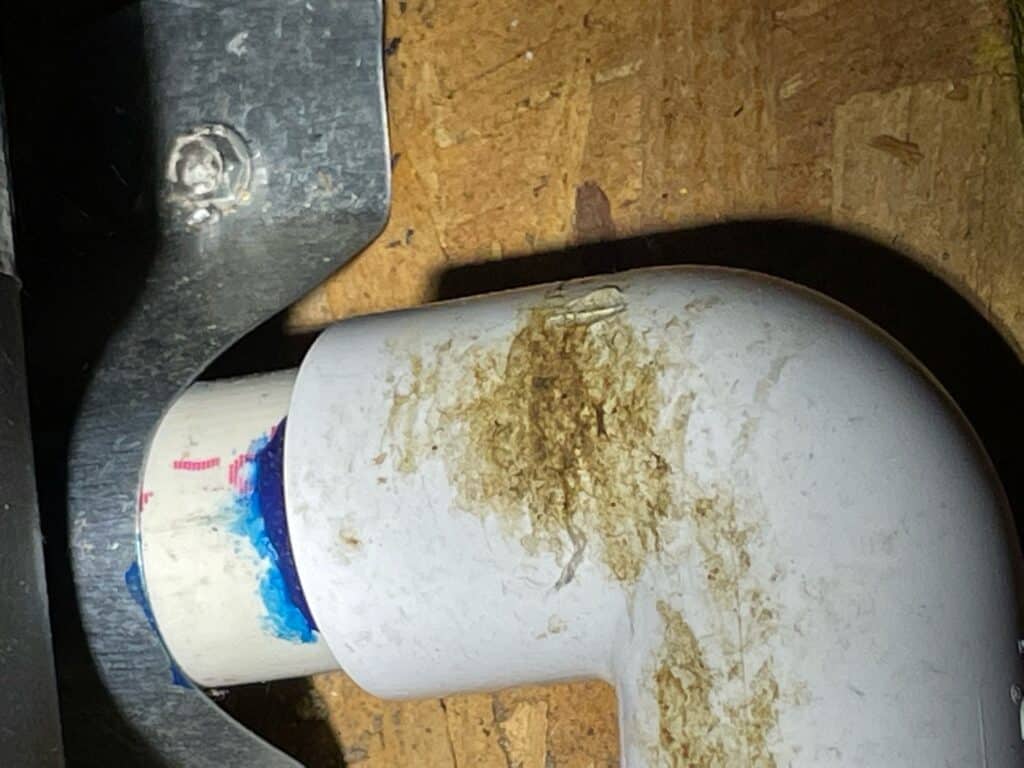
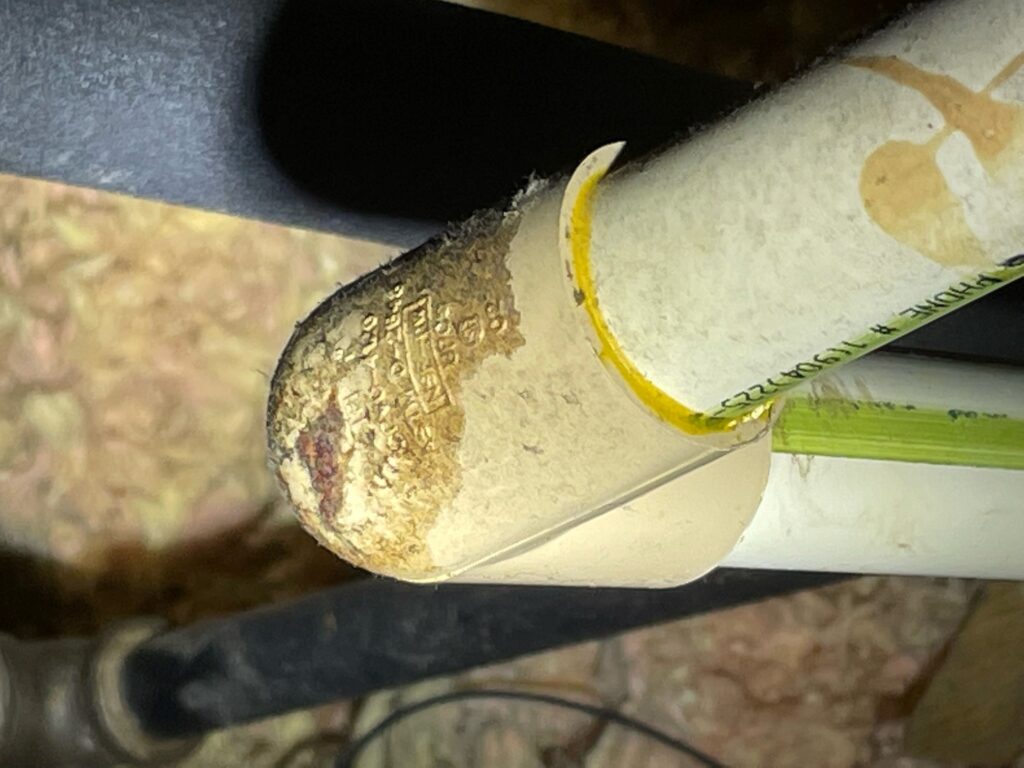
Nuisance wildlife often leave rub marks as they move around your home. These marks typically appear as dark smudges or streaks on exterior surfaces such as walls, siding, and trim. The rub marks are caused by the natural oils and dirt on the animal’s fur transferring onto the surfaces as they repeatedly rub or brush against them.
Common locations for rub marks include entry points, such as gaps around doors and windows, as well as along travel routes and near nesting sites. These marks can vary in size and intensity depending on the type and size of the animal, with larger animals like raccoons and squirrels leaving more noticeable marks.
Identifying rub marks on your house can serve as an indication of wildlife activity and potential entry points, prompting homeowners to take action to prevent further damage and intrusion.
Animal Tracks or Runs
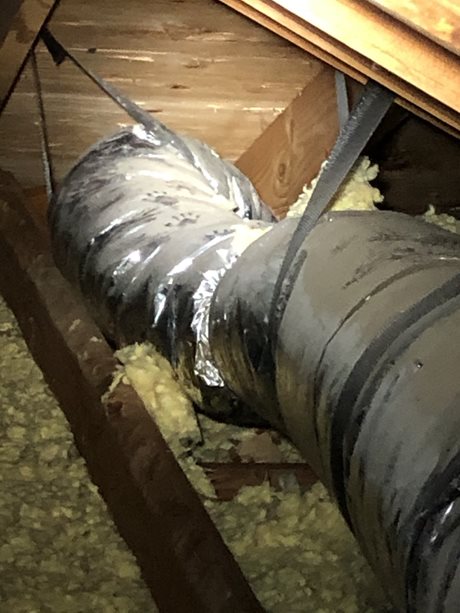
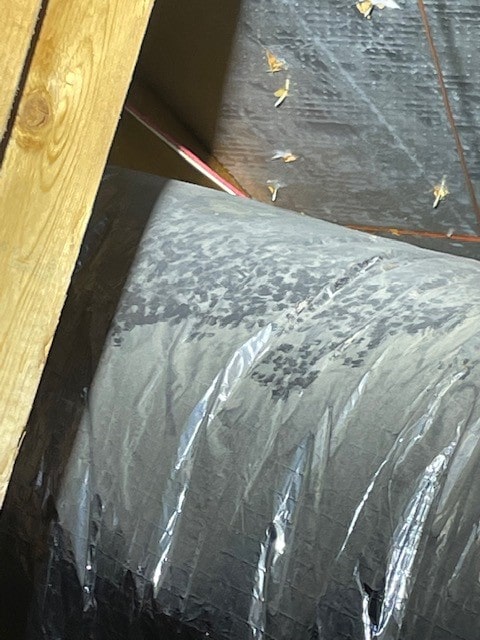
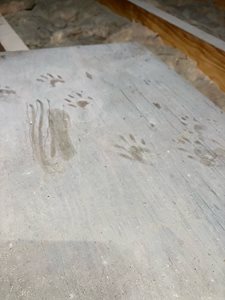
Animals in the attic will leave behind evidence of their movement.
Another indicator that animals will leave behind is paw prints on your ductwork. Opossums and raccoons have the biggest prints. They each have five fingers, but the palm of an opossum’s print is more triangular. Squirrels and rats have much smaller prints with their front feet having four toes and their hind feet having five.
When dealing with mice, rats, and even flying squirrels, you might see tunneling in an attic’s insulation. Typical tunnels are about three inches in diameter.
Animal Damage
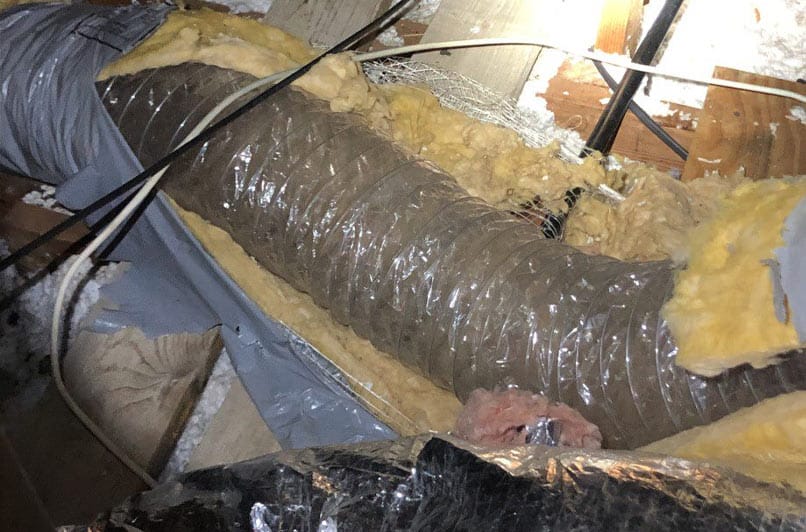
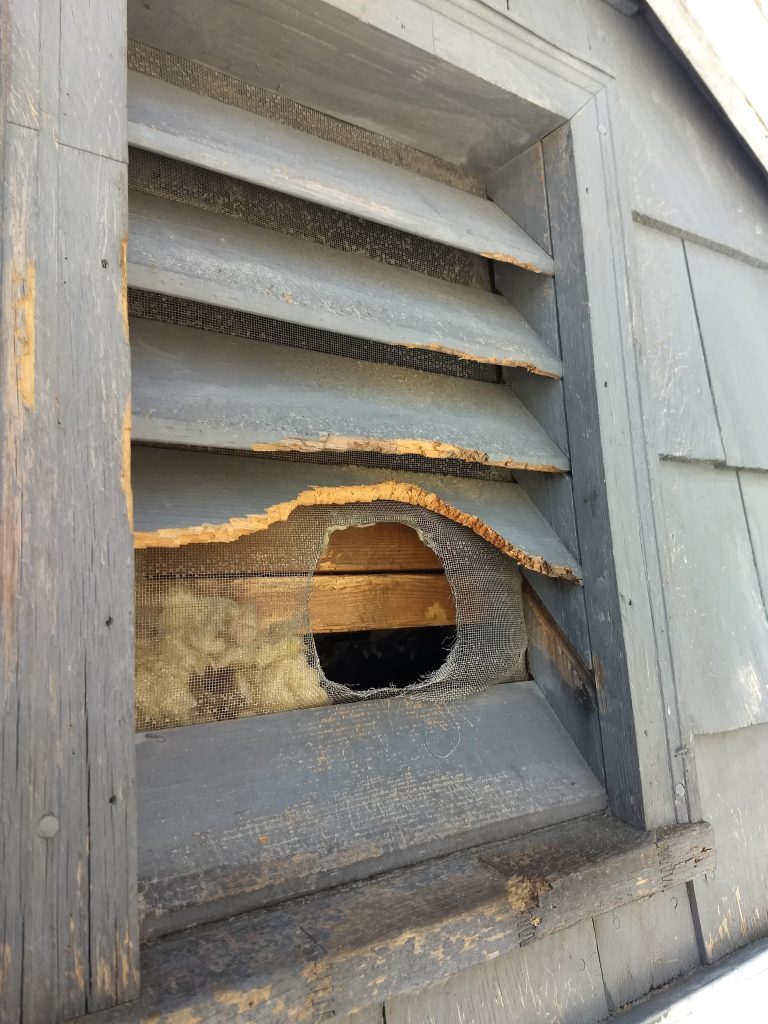
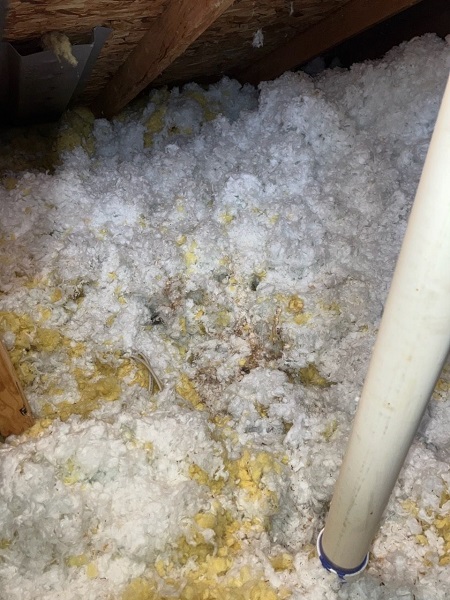
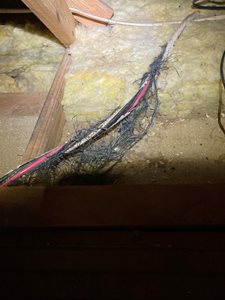


Beyond waste and noises, any damage is another way to confirm that a critter is living in your attic. If left unchecked, these critters can cause not only noise but damage as well. Stored items in your attic are at risk for nuisance wildlife damage. Squirrels and rats will use cardboard boxes and their contents to create nests.
Animals will destroy insulation. Raccoons will dig up insulation to create nests. Norway rats create burrows through it. Any animal in the attic will contaminate the insulation with feces and urine.
https://www.crittercontrol.com/blog/raccoons-signs/Raccoons will often tear up ductwork or wallpaper. Rodents chew the wood and the electrical wires—creating potential fire hazards—and rats will live in your attic, breeding in high numbers. Frayed electrical wires are a significant fire hazard.
Since they’re warm and often undisturbed by humans, attics make great nesting options for many unwanted critters. These pests seek shelter in attics to survive harsh weather during winter or raise young during the spring.
Many different animals enjoy living in attics. But here are a few of the most common:
- Raccoons. Raccoons are excellent climbers that will happily make your attic their home.
- Bats. Bats need a place to roost during the day, and your attic is the perfect spot.
- Squirrels. Squirrels of all kinds enjoy making nets in cozy attics.
- Rats. Rats can scurry up to the top floor of your abode to settle in.
- Mice. Mice are often found sheltering in human structures. The quiet attic space is a common spot where they fly under the radar.
- Birds. If given the opportunity, birds may make a nest in your attic.
Animals can enter your home through many different locations. The most common areas where we see animals entering are soffits, eaves, gable vents, roof returns, pipe stacks, any damaged areas on a property, and even any construction gaps. Rats can fit through entry points as small as the size of a quarter, and mice can fit into a gap just over ¼ of the size of a quarter.
Animals can even enter your home if there is not an entry point present. Raccoons are tenacious, resourceful, and strong. If they want to use your home as shelter, they will use their hands to create an opening. Raccoons can tear apart shingles and break through the plywood. Rodents like squirrels, mice, and rats constantly gnaw. Rodents easily create entry holes by gnawing through materials like wood, pipes, plastic, metal, brick, and electrical wires.
Chimneys
Chimneys, by definition, must be able to open to the sky to expel smoke, and many people don’t bother closing their flues.
Roof Ridge
The roof ridge provides another entry point. Most roofs have a ridge vent which raccoons can exploit the opening to create a bigger one. But raccoons don’t need to find a weakness. They have the strength and tenacity to tear through shingles and plywood.
Roof Edge
A fascia board is a thin longboard that runs along the lower outer edge of your roof and covers the entire roofline. Not only do fascia boards hold the gutters but also they provide ventilation. It is not uncommon to find a construction gap between the fascia board and the roof line.
Raccoons take advantage of the construction gap.
Loose Shingles
Raccoons have the strength and tenacity to tear through your roof. Shingles and plywood eventually succumb to a raccoon’s will. They don’t even need a large hole. For an animal that can be as large as twenty pounds, raccoons only need a gap the size of a grapefruit.
Soffits
A soffit is any finished material installed to cover the underside of the roof overhang. Soffits protect from the weather, bugs, mold, rust, and other pests. Raccoons can find gaps in improperly installed soffits or tear open a new entry hole.
Roof Vents
A home needs to breathe. Proper ventilation along the roof can extend the lifetime of your roof, improve energy efficiency in your home, and make the home a healthier place to live.
Ridge vents, box vents, and roof turbines remove stale air from your attic;, whereas soffit vents, gable vents, and over-fascia intake vents bring in fresh air. These vents also present a natural entry point for raccoons. Usually, the materials of these vents will stop a raccoon.
Plumbing Stacks
Rats and mice can use plumbing stacks to enter your house. Some rats are excellent swimmers and will climb through your toilets!
How to Find Animal Entry Holes
Pest animals can squeeze through surprisingly small gaps. A mouse only needs a pencil-sized hole. Pest animals can more easily access parts that are harder to reach for people. During the Critter Control inspection, we start where you notice an animal issue. From there, we investigate the different signs of animals in the attic. Paw prints, rub marks, and animal droppings usually point toward an entry hole.
The Critter Control expert will investigate the exterior of the roof. They have the experience to find the entry holes and training to do it safely.
Do not attempt to inspect your roof without proper safety equipment!
The inspection is essential for long-term wildlife control. We identify all current and potential entry holes. The whole home exclusion has solutions to properly seal all animal entry points.